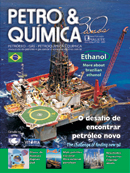|
Edição 292 • 2007 |
| Demanda aquecida preserva lucros de petroquímicas
Heated demand preserves petrochemical company profits [click to read in english] |
| Em um ano marcado pelas altas recordes nos preços das matérias-primas, o resultado financeiro apresentado pelas petroquímicas até que pode ser considerado bom: impulsionadas pelo crescimento da demanda e dos preços, as empresas fecharam o ano no azul. É bem verdade que os custos comprimiram as margens, mas a expressiva geração de caixa equilibrou as contas. Entre as petroquímicas que já divulgaram seus balanços, o maior lucro foi apresentado pela Copesul, que bateu recordes de vendas: R$ 644,8 milhões – resultado 8,0% superior ao obtido em 2005 e o novo recorde histórico da empresa. Destaque também para a Petroquímica União, que fechou o ano com um lucro 80% superior ao apresentado em 2005: R$ 148 milhões contra R$ 82 milhões. Ao longo do ano, as indústrias petroquímicas viram seus resultados afetados pelos custos da matéria-prima – em 2006 os preços internacionais da nafta subiram 19% em relação ao ano anterior. O repasse dos custos só foi possível graças ao aquecimento da demanda, observado a partir do segundo semestre no mercado interno – segundo dados da Comissão Setorial de Resinas Termoplásticas da Associação Brasileira da Indústria Química – Coplast, o consumo aparente de resinas termoplásticas cresceu 6,88% no ano. Para se ter uma idéia, basta tomar como exemplo a Braskem, que fechou o ano com uma receita bruta de R$ 15 bilhões, mas com o custo dos produtos vendidos em R$ 9,9 bilhões – fortemente impactado em R$ 756 milhões por aumentos nos custos de matéria-prima e energia. Resultado: o lucro caiu 88%, fechando o ano em R$ 82 milhões. Os negócios realizados no segundo semestre equilibraram as contas da Suzano Petroquímica – que fechou o ano com as contas equilibradas em R$ 16 mil. “O prejuízo de R$ 29 milhões no primeiro semestre, devido aos picos no preço do petróleo e preços baixos de resinas no mercado interno, foi compensados por outros R$ 29 milhões ganhos na segunda metade do ano”, explicou o co-presidente da empresa, João Pinheiro Nogueira Batista. “Tivemos um primeiro semestre bem difícil até que se acomodasse a entrada da Riopol no mercado. No segundo semestre o cenário melhorou e tivemos sucesso no repasse do aumento das matérias-primas. Com isso os preços foram melhores, o que possibilitou recuperar o negócio”, resume o diretor-superintendente da Ipiranga Petroquímica, Alfredo Tellechea. A empresa fechou o ano com lucro de R$ 321,8 milhões – 17,6% superior ao resultado apresentado em 2005. |
| Heated demand preserves petrochemical company profits |
| In a year that stood out for the record highs in raw material prices, the financial results of the petrochemical companies could even be considered good: boosted by the growth in demand and in price, the companies closed the year in the black. While it is true that costs squeezed margins, substantial cash generation balanced the accounts. Among the petrochemical companies who have already published their balance sheets, Copesul posted the greatest profit, with record-breaking sales: R$ 644.8 million – a result 8.0% greater than that obtained in 2005 and a new record in the company’s history. Petroquímica União also stands out, having closed the year with profits 80% greater than those of 2005: R$ 148 million against R$ 82 million. Throughout the year, the petrochemical industries saw their results affected by raw material costs – in 2006, international prices for naphtha rose by 19% compared with the previous year. Passing on these costs was only possible thanks to the increased demand observed on the domestic market beginning in the second semester – according to data from the Thermoplastic Resins Sector Commission of the Brazilian Chemical Industry Association – Coplast, apparent consumption of thermoplastic resins grew by 6.88% for the year. Just to have an idea, taking Braskem as an example, the company closed the year with gross revenues of R$ 15 billion, while the cost of goods sold was R$ 9.9 billion – strongly affected by the R$ 756 million in increased costs of raw materials and energy. The result: profits fell by 88%, closing the year at R$ 82 million. Business done in the second semester balanced the accounts at Suzano Petroquímica – who closed the year with the accounts in balance at R$ 16,000. “The losses of R$ 29 million in the first semester due to the spikes in oil prices and the low prices for resins on the domestic market were offset by the R$ 29 million earned in the second half of the year”, explained the co-chief executive officer of the company, João Pinheiro Nogueira Batista. “We had a very difficult first semester while we adjusted to the entry of Riopol in the market. In the second semester, the scenario improved and we were successful in passing on the increase in raw material. This boosted prices, which enabled the business to recover”, summarizes the director superintendent of Ipiranga Petroquímica, Alfredo Tellechea. The company closed the year with a profit of R$ 321.8 million – 17.6% up on the result presented in 2005. |
 |
|
||||||||||||||||||||||||||||||||||||